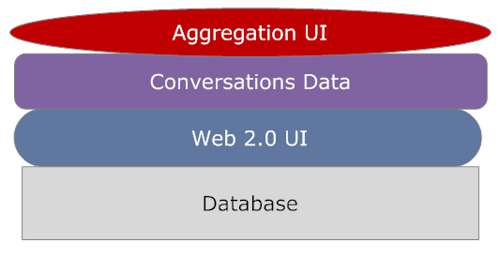
Image by monsieurlam via Flickr
This is another one of my thinking/blogging out loud posts so your feedback is appreciated and encouraged. I would also like to note that I am not a programmer and I’m sure my description of databases and UI is laughable to anyone that knows what they’re doing but these analogies work for my purposes
I don’t think anyone (or at least anyone reading this) would argue that the Web is evolving at an exponential rate.
I’ve begun to think of the Web and our activities on it in a new way. It reminds me of the way archeologists discover ancient cities.
You have one layer that may be the aqueducts or catacombs with a city built on top. Then a major war, volcano or new ruler comes along, wipes everything out and builds a whole new city right on top of the old one.
Databases and the Old Web
At the core of everything we do on the Web are countless numbers of databases processing 0′s and 1′s. On top of that raw data programmers and designers build user interfaces (UI) that allow us to read and interact with that data.
Web 2.0
A lot of the meaning was lost behind the buzz around Web 2.0 but at the core (my definition) Web 2.0 is the capabilities behind social media. RSS, AJAX, etc have enabled the programming inept (aka regular people) to become mini-media empires.
We can start a blog (or several), fill out dozens of social profiles, join social networks like Twitter, Facebook and LinkedIn and easily start reaching hundreds of people interested in what we have to say. If we are moderately good at it we can reach thousands with very little extra effort.
The problem is that all of those millions of conversations, in aggregate, become as un-consumable as the raw data that lays at the core.
So with the Old Web the database was processed into a consumable UI and with Web 2.0 that database is filtered with a UI that allows us to then create more data in the form of conversations.
What I see happening now is only the tip of the iceberg; we are creating new layers of user interfaces to aggregate and consume that conversation data.
Look at sites like Alltop, ExecTweets or the recently announced Tinker. These are efforts to create another layer of UI over the conversation data.
As marketers I think a huge opportunity is to harness past, present and future conversation data in targeted efforts using a new layer of of aggregation UI.
How would this work?
Imagine you want to target Moms. Let’s also imagine that your company has a company blog or several blogs that contain useful information for moms (even if you don’t this would still work). To date the main approach has been to sponsor popular mom blogs. There’s nothing wrong with this but I think companies could take it to the next level.
Why not create a site that integrates the best blog content across several, if not dozens of, mom blogs as well as content from your company blogs (past content)? The site would also aggregate real time posts from select mommy blogs as well as your company blogs while simultaneously integrating Twitter and creating a presence on Facebook (present content). The site and the Facebook pages would also encourage and reward participation from moms (future content).
I think that as conversation data continues to explode (and believe me, it will)marketers need to look at this as a huge opportunity not a problem. Let’s get creative and innovate around not just our products but how we communicate with our customers.
